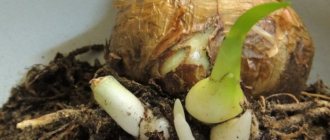Crocuses: cultivation and care. This flowering plant is a corm and belongs to the Iris family. Translated from Greek as “thread”. Possibly due to the thin, thread-like leaves of the plant. Perhaps because of the stigmas of flowers of certain varieties, from which the world famous spice saffron is obtained. If you decide to grow crocuses, growing and caring for them will not take much time and effort. But already in early spring the garden will be filled with colorful islands of delicate, amazing, beautiful flowers.
Crocuses: cultivation and care
Crocus or saffron: description of the flower
These are representatives of the Iris family - perennial corms resistant to cold. Their flowers are shaped like a glass, a star or a bowl .
The grass-like leaf is often crossed by a white vein. Note! In the evening and in cloudy weather, the flower petals close.
Most crocuses are single-flowered, but there are species with two or more flowers. Thanks to simple care before, during and after budding, these specimens are grown not only in flower beds, but also in the house.
Storing and preparing bulbs
To force crocuses, bulbs purchased in a retail chain, on the Internet, or dug up from a yard flower bed can be used.
Homemade bulbs are dug up no later than mid-summer, large healthy specimens are selected, cleaned of soil, and dried for 5-7 days at temperatures up to 34 °C. Then they are placed in a perforated cardboard box and stored for up to two weeks at 20 °C and the same at 17 °C. After this, the bulbs are given a short-term cold period of rest. They are placed in paper bags and transferred to the refrigerator section with low positive temperatures for 30 days. Bulbs purchased in a store must also be kept in the cold for at least 2 weeks.
Types and varieties of crocus
There are many varieties of this beautiful plant. And each one pleases with its unique appearance.
Spring crocus vernus
May have one flower or several. The plant has a variety of colors : from plain white, various shades of purple to striped specimens.
The flowering period occurs in the second half of April.
Two-flowered crocus biflorus
Features a wide variety of shades. Light tones of blue with a lilac tint inside the petals and brown spots on the outside. There are completely white petals, covered with brown stripes on the outside.
The snow-white or yellow throat makes an attractive contrast with the main tone.
Golden crocus chrysanthus
The height of the plant is no more than 20 cm. The bulb is spherical and slightly flattened. The leaves are very narrow. A distinctive feature of the species is the perianth with edges curving outward .
Tomasini crocus tommasinianus
One bulb produces three star-shaped flowers. Their length is within 6 cm. The perianths are lilac with a pink tint , with a white stripe along the edge.
The budding period begins in April and lasts about three weeks.
Note! Many novice gardeners are interested: if the crocuses have bloomed in a pot, what to do next? After budding, you need to remove the dry peduncle and continue care, which should include watering and fertilizing.
How to prepare crocuses from the garden for forcing
How to grow a crocus in a pot, how to care for it if the bulbs are dug up in a garden plot or grown in a flower bed? This material is also suitable for planting. It is better if these are large-flowered varieties of the Dutch group:
- “Flower Record” (dark purple) - most often used for forcing;
- "Remembrans" (purple);
- “Vangart” (light blue, lilac) - early variety;
- “Nigro Boy” (dark purple) - late;
- "Joan of Ar" (white);
- "Yellow Mammoth" (yellow).
The process of preparing selected bulbs for forcing takes at least three months. In June, crocuses are dug out of the ground in a garden plot or rock garden.
Then large specimens without visible defects are dried and selected for forcing, which will make a beautiful crocus in a pot.
How to care for corms so that the result of forcing is excellent?
Autumn-blooming crocuses
Is there anything more beautiful than delicate buds against the background of yellowed foliage? These flowers give you a mood and make you believe that there is a place for beauty in any situation.
Beautiful crocus speciosus
Differs in different colors . The most common shade - from the inside the petals turn from light lilac to a deeper tone. Additional decoration is provided by the finest touches.
Nice crocus pulchellus
An unusually delicate plant in its color. Wisteria-colored petals are dotted with cobwebs of a deeper tone. The diameter of the flowers is from 6 to 8 cm . There can be about 10 of them on one plant. They open in September – October. Tolerates light frosts.
Banatian crocus banaticus
Its leaves are lily (about 15 cm long) . The flowers are large, similar in appearance to irises. The perianth lobes reach 5 cm. The overall color is dominated by cool tones of lilac.
Dutch crocus hybrids
They have quite large flowers in almost all shades of purple . Snow-white ones are also found. For crossing, narrow-leaved, spring and yellow specimens were used.
Description of culture
The bulbous flower belongs to the Iris family. It grows mainly on plots of land, in flower beds, flower beds, but it is also possible to grow in containers. Flowers grow up to 20 cm. The characteristic narrow green foliage grows from a tuber located in the ground.
A unisexual plant provides an inflorescence of a bright color; in the center of the flower there is a stigma containing stamens of red and orange colors. Crocus flowers are pollinated by insects. Plants of purple, blue, white and yellow colors, variegated varieties, and hybrids are common.
Bulbs of the crocus flower are also eaten, which are boiled, fried, stewed and simmered. Stigmas become a sought-after component of the plant; saffron, which is a culinary spice, is made from them; it is also used as a dye and medicine.
Crocuses: planting and care at home
Choosing a flowerpot
Before you plant crocuses in a pot at home, you need to choose the right container. You will need wide dishes with low sides . From 5 to 10 bulbs should fit into the pot, without touching each other or the walls of the container.
Advice! It is necessary to take care of drainage holes in advance.
The soil
The substrate is fertile and light. To do this, mix equal parts of leaf and turf soil and add ½ part of peat and sand. You can take any soil and add sand .
If the planting material is chosen incorrectly, then you can forget about flowering.
Tips and recommendations from experienced flower growers and summer residents
Experienced summer residents distill saffron at home. The entire cycle that it goes through in its natural environment is repeated for the flower, thus helping the plant to bloom at the right time. In June, the bulbs must be dried and then calcined at a temperature of +34°C for about 7 days. Then the temperature drops to +22-23°C and decreases every 14 days until it reaches +17°C. This falls in mid-August. Then the crocus bulbs are hardened and kept for a month at a temperature of +6°C.
Rooting flowers
The last stage is rooting the flowers - the saffron is planted in a pot. When planted in September, the crocus will begin to bloom in January. If it is necessary to delay the process, then extend the rooting period.
Like all bulbous plants, crocuses should not be disposed of after they have flowered. They can be literally given a “second life” and get a new harvest from the old one next year.
5 4 votes
Article rating
Growing crocuses in a pot
Since this plant is easy to care for, it can be grown in flowerpots. It is enough to follow some rules.
Watering crocuses
These plants do not tolerate waterlogging. Watering is carried out no more than 2-3 times a week , only after the top layer of soil has completely dried.
Important! Blooming crocuses are watered using a tray (after 30 minutes, excess water is removed).
Fertilizer and feeding
No fertilizing is required during planting. Next, you should choose fertilizers based on potassium and phosphorus . These plants respond best to them. Fertilizers are applied with the first shoots (diluted in a ratio of two to one), as well as when buds are planted.
In addition, be sure to fertilize crocuses after flowering. It is better to avoid nitrogen-containing drugs.
Care for long-term flowering
The bottom of the container is covered with broken bricks or tiles. The pots are placed in wide trays where excess moisture will drain. When the sprouts reach 3–5 cm, they must be placed in a bright place. The optimal temperature is 10–15 degrees Celsius .
At night there can be drops even to zero and below. At + 20 or higher there will be no flowering. It is also worth protecting crocuses from direct sunlight and artificial lamps.
The video below explains how to care for Crocus at home before and after flowering.
What conditions does the plant need?
Crocuses cannot be called whimsical plants, the main thing is that the following conditions are met:
- Low temperature - up to 20 degrees, in winter even up to 10.
- Sufficient lighting.
- You need to water a little, but regularly.
- Soil drainage.
After forcing, the plants should be left until the leaves are completely dry, but watering cannot be stopped. The bulbs are then left for storage.
Soil composition and pot volume and drainage
To choose the right pot, first determine how many bulbs you want to plant. Usually this is 5-10 pieces. The main thing is not to allow the bulbs to touch each other or the walls, so choose a low and wide pot. You can buy pots at a flower shop designed for forcing bulbs.
The soil requirements for crocuses are neutrality, lightness and drainage. You can take a flower substrate or prepare a mixture yourself from the following components, taken in equal parts:
- coarse sand;
- turf mixture;
- leaf mixture.
Another option is a thick layer of sand at the bottom, then soil, but this is only used if you later plan to use the crocus for propagation. Gravel, pieces of bricks, and tiles are sometimes also used for drainage. The pot itself must be placed on a tray where the water will flow out.
Choosing a place
On the one hand, these plants love light, so the south side of the house is best suited for them. But the temperature regime is also important. The ideal place is on the balcony. There, during the spring months, the necessary coolness is maintained, and by the time of flowering, in March-April, the air warms up to 16-20 degrees.
Lighting
Lighting depends on what stage of growth the plant is at. If you have just planted crocuses, then you need to keep them in a dark place until the sprout grows to 5 centimeters and becomes strong. Then you need to move the plants to a well-lit place where they will be exposed to sunlight for at least 4 hours a day. Move them into the shade again during flowering to keep the flowers open longer.
Temperature
Crocuses that are about to bloom or have already bloomed should be kept in the coolest place in the house. The ideal temperature is +14-16 degrees. At +20 and above, plants bloom for a very short time, and after a few hours they can shed their petals. At night, even frosts down to -3 are acceptable.
Humidity
Crocuses are drought-resistant, so they do not require abundant watering. But drainage is very important, otherwise the bulbs will rot. Under no circumstances should water stagnate in the ground. It is permissible to spray plants, but also infrequently and little by little.
State of rest
The crocus goes into a dormant state after all the leaves dry out. This period falls in the summer months
It is important to store the bulbs correctly; to do this, place them in a cool, dark and dry place. No watering is required at this time to prevent the bulbs from rotting.
Possible problems during cultivation
It is necessary to choose the right planting time. For autumn-blooming crocuses this is summer , and for spring-blooming crocuses it is September. For forcing in a pot, those specimens that bloom in spring are ideal.
Advice! It is not recommended to plant crocuses of different varieties in the same container. They do not have the same bud period and flower size. The flowerpot will not look aesthetically pleasing.
With poor feeding and poor drainage, chlorosis develops. The leaves are turning yellow. It is better to moderate watering.
Suitable varieties for home
Dutch varieties are recommended as potted plants. These include the following:
- Prins Claus produces a pleasant and long-lasting aroma; when the appropriate conditions are created, it can bloom in winter;
- Jeanne D'Arc resembles snowdrops, only with larger flowers, the core of the buds is golden;
- Flower Record with a small stem, but voluminous inflorescences of a rich purple color;
- Blue Pearl means blue pearl; variety with azure buds, yellow at the base.
As a rule, flower growers do not stop at just one option; they create entire kaleidoscopes of different crocuses on their windowsills. The only condition is not to plant dissimilar varieties together in one container, otherwise you may end up with sprouts of different sizes and non-simultaneous flowering. The following varieties are also suitable as indoor flowers:
- Cream Beauty (delicate creamy shade);
- Golden Yellow (hybrid);
- Remembrance (rich lilac color);
- Crocus Oxonian (with dark blue buds and golden-orange core).
Pests and diseases of crocuses
Buds covered with light spots and deformed petals indicate the presence of a viral infection. You need to get rid of such a specimen and disinfect the soil with a solution of potassium permanganate.
The bulbs are also often affected . They soften, the scales separate, and spots are visible underneath. It's a fungus. For preventative purposes, the bulbs are dried and treated with antifungal drugs before planting.
Means and methods
Crocus or saffron is a delicious spring primrose grown in certain climates, often on an industrial scale, to produce a special seasoning with an unusual taste.
Greek and Iranian saffron, which has a unique and refined aroma, is especially valued.
Like any bulbous plant with beautiful flowers (such as tulips or hyacinths), bulbs can be germinated and forced to bloom by providing them with the appropriate conditions.
Features of forcing
Blooming crocuses are a real decoration. It is not difficult to drive out these plants . We offer some simple tips.
Selection of planting material
Dutch hybrids are the most suitable for this. With their help you can get large and impressively beautiful plants. When choosing a variety, it is better to focus on flowering periods. The bulbs must be completely healthy and have a diameter of at least 5 cm.
Cooling
Rooting of bulbs in nature occurs successfully at low temperatures. You can place containers in garden soil. But there is another option: use a refrigerator or cellar , where the temperature is kept between +4–9 degrees.
Each pot is sealed with film. When dry, the soil is moistened.
Rooting flowering
For positive results, you should cool the bulbs before planting and choose the right containers and soil. Keep the plantings in the dark for a couple of months (until green sprouts appear).
This video talks about the features of forcing Crocuses.
This video shows the forcing of Crocuses after three months.
Landing
Into the ground
The planting site must be cleared of grass, weeds, and stones. The distance between plants and planting depth depend on the size of the bulb.
The corms are placed in the ground in separate holes made with a peg - approximately 10 cm deep and at a distance of 7-10 cm between individual flowers. Because they look best in clumps, you can place a few to a dozen bulbs in one area.
It is also convenient to use a special device - a seeder for bulbous plants, which allows you to easily make a hole in the soil of the required depth.
It is ideal to plant crocus bulbs in groups of 3-9.
The bulbs are planted in holes and covered with pre-dug soil on top. Even if the bulb leans when soil is added, the plant will naturally correct the position over time.
On the lawn
Crocuses can be planted on the lawn. You need to choose a suitable sunny, fairly safe place, because crocuses cannot withstand trampling.
Work order:
- You need to cut the lawn with a spatula and remove the grass to a depth of 8-10 cm.
- Flower bulbs are planted in the resulting area, sprinkled with soil, and the soil is lightly compacted. Cover with previously removed turf.
- The turf should not be too dense to allow flowers to reach the surface. Plantings are watered.
So it’s worth planting the bulbs in special baskets that make them easier to dig up and find later. Baskets also prevent flowers from spreading across the lawn. Planted bulbs need to be watered abundantly.
Basket for planting bulbous plants
In pots
Crocus is ideal for growing in pots. You should choose large, healthy tubers, which are planted in flat pots in the fall. If flowers planted in pots are kept for 10 weeks in a shaded room with a temperature below 9 °C, and after this time at the end of January they are moved to a room with a temperature of 15-17 °C, beautiful purple, yellow, white flowers can be obtained , which will bloom earlier than in nature.
Pests of culture
Often, when planting crocuses in the ground, pests become rodents that dig holes in the soil and feed on the bulbs. Sometimes animals nibble on rhizomes, but it also happens when mice and moles carry them into holes.
If damaged, the tubers rot, the plant is taken out and becomes weak. When flower bulbs are damaged by rodents, the tuber is cut off, sprinkled with ash, and then dried in air for several hours.
To prevent rodents from visiting the site, it is recommended not to leave sods with grass on the territory, as the animals form nests in it. Since mice often do not move further than three meters from the nests, it is better to clean the area within such a radius.
Caterpillars of butterflies that fly around crops can also damage plant rhizomes. They are noticeable during weeding carried out in the fall. In this case, they are treated with fungicides and insecticides.
The description of the crocus plant provides growing rules for the healthy development of the plant. It is important to ensure normal substrate quality. Clay soil becomes a habitat for underground slugs, which also feed on plant rhizomes.
They get rid of them with special preparations sold in gardening stores. For prevention, add a layer of sand during planting.











